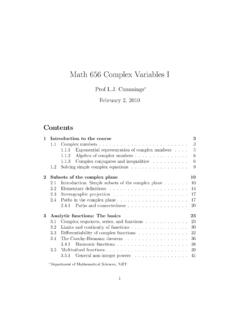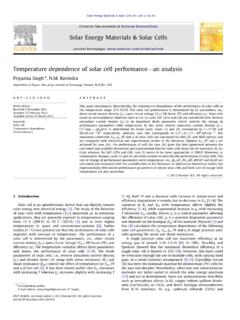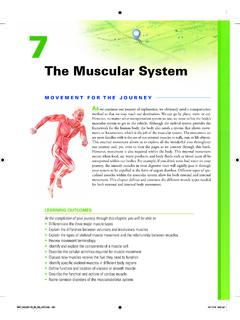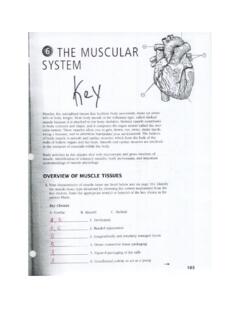Transcription of MUSCULAR SYSTEM Introduction – Functions and basic types ...
1 A. K. Sengupta 9/9/2010 1/12 MUSCULAR SYSTEM Introduction Functions and basic types of muscle cells Skeletal muscle cells and connective tissues The nervous SYSTEM Mechanism of muscle contraction Motor unit Action potential basis of EMG Length tension characteristics Force regulation in skeletal muscles Energy consideration of muscle contraction Cellular respiration Fatigue in static and dynamic MUSCULAR work Functions The MUSCULAR SYSTEM is composed of specialized cells called muscle fibers. Their main characteristic is their ability to contract. muscles , where attached to bones or internal organs and blood vessels, are responsible for movement. Nearly all movements in the body are the result of muscle contraction. The integrated action of joints, bones, and skeletal muscles produces obvious movements such as walking and running.
2 Skeletal muscles also produce more subtle movements that result in various facial expressions, eye movements, and respiration. In addition to movement, muscle contraction also fulfills some other important Functions in the body, such as posture, joint stability, and heat production. Posture, such as sitting and standing, is maintained as a result of force produced by muscle contraction. The skeletal muscles are continually making fine adjustments that hold the body in stationary positions. The tendons of many muscles extend over joints and in this way contribute to joint stability. This is particularly evident in the knee and shoulder joints, where muscle tendons are a major factor in stabilizing the joint. Heat production, to maintain body temperature, is an important by-product of muscle metabolism.
3 Nearly 85 percent of the heat produced in the body is the result of muscle contraction. A. K. Sengupta 9/9/2010 2/12 muscles types There are three types of muscles : skeletal, smooth, and cardiac. Skeletal muscle, attached to bones, is responsible for skeletal movements. These muscles are under conscious or voluntary control. These muscle fibers are striated (having transverse streaks when seen under microscope). Smooth muscle, found in the walls of the hollow internal organs such as blood vessels, the gastrointestinal tract, bladder, and uterus, is under control of the autonomic nervous SYSTEM . Smooth muscle cannot be controlled consciously and thus acts involuntarily. They are microscopically non-striated (smooth) and contract slowly and rhythmically. Cardiac muscle, found in the walls of the heart, is also under control of the autonomic nervous SYSTEM , thus involuntary.
4 The cardiac muscle cell is striated, like skeletal muscle. The cardiac muscle cell is rectangular in shape. The contraction of cardiac muscle is involuntary, strong, and rhythmical. Physical Structure of Skeletal Muscle Each muscle consists of skeletal muscle tissue , connective tissue , nerve tissue , and blood or vascular tissue . Skeletal muscles vary considerably in size, shape, and arrangement of fibers. They range from extremely tiny strands such as the stapedium muscle of the middle ear to large masses such as the muscles of the thigh. Each skeletal muscle fiber is a single cylindrical muscle cell. An individual skeletal muscle may be made up of hundreds, or even thousands, of muscle fibers bundled together and wrapped in a connective tissue covering. Each muscle is surrounded by a connective tissue sheath called the epimysium.
5 Fascia, connective tissue outside the epimysium, surrounds and separates the muscles . Portions of the epimysium project inward to divide the muscle into compartments. Each compartment contains a bundle of A. K. Sengupta 9/9/2010 3/12 muscle fibers. Each bundle of muscle fiber is called a fasciculus and is surrounded by a layer of connective tissue called the perimysium. Within the fasciculus, each individual muscle cell, called a muscle fiber, is surrounded by connective tissue called the endomysium. Skeletal muscle cells (fibers), like other body cells, are soft and fragile. The connective tissue covering furnish support and protection for the delicate cells and allow them to withstand the forces of contraction. The coverings also provide pathways for the passage of blood vessels and nerves.
6 Tendon: Commonly, the epimysium, perimysium, and endomysium extend beyond the fleshy part of the muscle to form a thick ropelike tendon or a broad, flat sheet-like aponeurosis. The tendon form attachments from muscles to the bones and aponeurosis forms connection to the connective tissue of other muscles . Typically a muscle spans a joint and is attached to bones by tendons at both ends. One of the bones remains relatively fixed or stable while the other end moves as a result of muscle contraction. Ligaments are fibrous tissues that connect bone to bone. Skeletal muscles have an abundant supply of blood vessels and nerves. This is directly related to the primary function of skeletal muscle, contraction. Before a skeletal muscle fiber can contract, it has to receive an impulse from a nerve cell.
7 Generally, an artery and at least one vein accompany each nerve that penetrates the epimysium of a skeletal muscle. The Nervous SYSTEM It is the major controlling, regulatory, and communicating SYSTEM in the body. It is the center of all mental activity including thought, learning, and memory. Together with the endocrine SYSTEM (producing hormones), the nervous SYSTEM is responsible for regulating and maintaining homeostasis (regulates internal environment so as to maintain a stable, constant condition). Through its receptors, the nervous SYSTEM keeps us in touch with our environment, both external and internal. The nervous SYSTEM is composed of organs, principally the brain, spinal cord, nerves, and ganglia (a mass of nerve tissue containing nerve cells A. K. Sengupta 9/9/2010 4/12 external to the brain or spinal cord).
8 These, in turn, consist of various tissues, including nerve, blood, and connective tissue . The various activities of the nervous SYSTEM can be grouped together as three general, overlapping Functions : Sensory, Integrative, and Motor. Millions of sensory receptors detect changes, called stimuli, which occur inside and outside the body. They monitor such things as temperature, light, and sound from the external environment. Inside the body, the internal environment, receptors detect variations in pressure, pH, carbon dioxide concentration, and the levels of various electrolytes. All of this gathered information is called sensory input. Sensory input is converted into electrical signals called nerve impulses that are transmitted to the brain. There the signals are brought together to create sensations, to produce thoughts, or to add to memory; Decisions are made each moment based on the sensory input.
9 This is integration. Based on the sensory input and integration, the nervous SYSTEM responds by sending signals to muscles , causing them to contract, or to glands, causing them to produce secretions. Neurons, or nerve cells, carry out the Functions of the nervous SYSTEM by conducting nerve impulses. They are highly specialized and amitotic. This means that if a neuron is destroyed, it cannot be replaced because neurons do not go through mitosis (cell division). The image below illustrates the structure of a typical neuron. Each neuron has three basic parts: cell body (soma), one or more dendrites, and a single axon. Dendrites are usually, but not always, short and branching, which increases their surface area to receive signals from other neurons. There is only one axon that projects from each cell body.
10 Axons terminate in many short branches or telodendria. The distal ends of the telodendria are slightly enlarged to form synaptic bulbs. Each of these synaptic bulbs innervates an individual muscle cell. Many A. K. Sengupta 9/9/2010 5/12 axons are surrounded by a segmented, white, fatty substance called myelin or the myelin sheath. The myelin layer increases the speed at which impulses propagate along the myelinated fiber. Myelinated fibers make up the white matter in the CNS, while cell bodies and unmyelinated fibers make the gray matter. Functionally, neurons are classified as afferent, efferent, or interneurons (association neurons) according to the direction in which they transmit impulses relative to the central nervous SYSTEM . Afferent, or sensory, neurons carry impulses from peripheral sense receptors to the CNS.

















